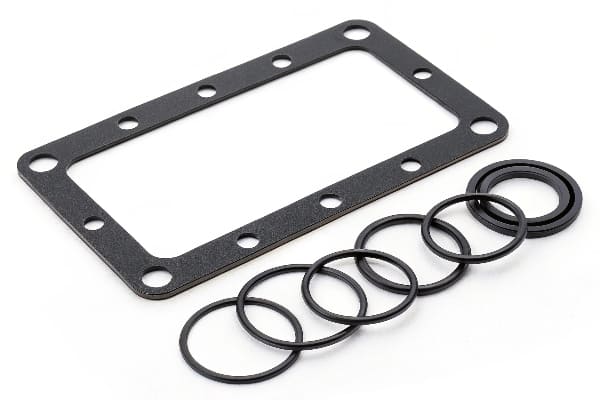Looking for the best material to ensure a leak-free oil gasket? Choosing the right material is essential for maintaining engine performance and preventing oil leaks. Let’s dive into the best materials for oil gaskets.
The best materials for oil gaskets are nitrile rubber (NBR), Viton (FKM), and silicone. These materials offer excellent sealing properties, resistance to oil and heat, and long-term durability.

Selecting the right material for oil gaskets is crucial for ensuring a tight seal in your engine or machinery. Let’s explore the materials that provide the best performance when exposed to oils and extreme temperatures.
What Are Oil Gaskets and Why Are They Important?
Are you wondering what oil gaskets do and why they are so important in your vehicle or machinery? Understanding their function will help you choose the best material for a reliable, leak-free seal.
Oil gaskets are sealing components used to prevent oil from leaking in engines and machinery. They must withstand high temperatures, pressure, and exposure to oils and chemicals.
Oil gaskets are essential components in engines, transmissions, and other machinery. They are designed to create a tight seal between two parts, preventing oil from leaking and ensuring smooth operation. Oil gaskets can be found in applications such as valve covers, oil pans, crankshafts, and transmission housings.
The material selected for oil gaskets1 must have specific properties to handle the demands of high-pressure environments and exposure to oils and temperatures. Without a proper seal, oil leaks can cause engine failure2, reduced efficiency, and damage to the surrounding components. That's why the gasket material3 must be durable, heat-resistant, and chemically compatible with the oils used in the system.
| Gasket Type | Common Applications | Ideal Material Choices |
|---|---|---|
| Oil Pan Gasket | Engine oil sump | NBR, Viton |
| Valve Cover Gasket | Engine valve covers | NBR, Silicone |
| Crankshaft Gasket | Engine components | NBR, Viton |
✅ Why it matters:
Understanding the role of oil gaskets and the importance of choosing the right material ensures that your engine or machinery operates efficiently without the risk of oil leaks.
Best Materials for Oil Gaskets
Wondering which material is best for your oil gasket? Let’s look at the top materials for oil gaskets and their unique advantages in sealing applications.
Nitrile rubber (NBR), Viton (FKM), and silicone are the best materials for oil gaskets. Each offers excellent oil resistance and high-temperature tolerance.

When choosing a material for oil gaskets, it’s essential to consider factors such as oil compatibility, temperature resistance, and mechanical properties. Here’s a closer look at the best materials for oil gaskets:
1. Nitrile Rubber (NBR)4
Nitrile rubber (NBR) is one of the most commonly used materials for oil gaskets due to its excellent resistance to oils, fuels, and other petroleum-based products. NBR is durable, versatile, and cost-effective, making it an ideal choice for many automotive and industrial applications.
- Best For: General oil sealing applications, automotive engines, fuel systems.
- Advantages: Excellent oil and fuel resistance, good abrasion resistance.
- Limitations: Limited high-temperature resistance compared to Viton.
2. Viton (FKM)5
Viton is a fluoropolymer elastomer that offers superior resistance to oils, high temperatures, and a wide range of chemicals. It is the material of choice for demanding oil sealing applications, especially in high-temperature environments like engine compartments or hydraulic systems.
- Best For: High-temperature seals, automotive engines, and chemical processing.
- Advantages: Excellent resistance to high temperatures, oils, and chemicals.
- Limitations: More expensive than other materials.
3. Silicone Rubber6
Silicone rubber is known for its excellent resistance to high temperatures and its flexibility. It is particularly useful in applications where high thermal stability and resistance to weathering or ozone are required. Silicone is also widely used in sealing applications for automotive engines, especially where a softer, more flexible material is needed.
- Best For: High-temperature environments, valve cover gaskets, automotive seals.
- Advantages: Excellent high-temperature performance, flexible, and durable.
- Limitations: Not as resistant to oils as NBR or Viton.
| Material | Oil Resistance | Temperature Range | Common Applications |
|---|---|---|---|
| Nitrile (NBR) | Excellent | -30°C to +100°C | Oil seals, fuel systems |
| Viton (FKM) | Excellent | -20°C to +250°C | High-temp seals, gaskets |
| Silicone | Good | -50°C to +250°C | Valve cover gaskets, seals |
✅ Why it matters:
Selecting the right gasket material ensures long-term reliability and performance in high-pressure and high-temperature environments.
How to Choose the Best Material for Oil Gaskets?
Not sure which material is right for your oil gaskets? Let’s break down the important factors to consider when making your selection.
Consider factors like oil type, temperature, and the specific application when choosing the best material for oil gaskets. NBR, Viton, and silicone are the top options for various needs.
Choosing the best material for oil gaskets depends on several factors related to the application:
- Type of Oil: Different oils have different chemical properties. NBR is great for petroleum-based oils, while Viton is ideal for aggressive chemicals and synthetic oils.
- Temperature Resistance: If the gasket will be exposed to high temperatures, Viton or silicone may be the best choices due to their excellent high-temperature performance.
- Mechanical Stress: Consider the amount of pressure and stress the gasket will face. NBR is great for general sealing, while Viton is better for high-stress and high-temperature applications.
- Environmental Factors: Exposure to ozone, UV light, or outdoor elements may require materials like silicone or EPDM, which resist weathering and aging.
Key Factors to Consider When Choosing Oil Gasket Material:
| Factor | Best Material Choices | Key Considerations |
|---|---|---|
| Oil Type | NBR, Viton | Match rubber with specific oil types |
| Temperature | Viton, Silicone | Choose based on the temperature range |
| Mechanical Stress | NBR, Viton | High-pressure environments need more durable materials |
| Environmental Exposure | Silicone, Viton | Consider weathering resistance and UV exposure |
✅ Why it matters:
By considering these factors, you can choose the most suitable material for oil gaskets, ensuring that your sealing components perform well over time and under demanding conditions.
Conclusion
When it comes to oil gaskets, materials like NBR, Viton, and silicone offer excellent performance depending on the specific application. NBR is best for general oil resistance, Viton excels in high-temperature and chemical environments, and silicone is ideal for high-temperature sealing. By evaluating factors like oil type, temperature, and application, you can choose the best material for your oil gasket needs.
🚀 Need Custom Rubber Solutions for Oil Sealing Applications?
Contact Julong Rubber today or Request a Custom Quote for high-quality rubber components tailored to your specifications!
Or reach out to us directly via WhatsApp:
-
Explore this link to understand the critical role oil gaskets play in preventing leaks and ensuring machinery efficiency. ↩
-
Discover the connection between oil leaks and engine failure to better maintain your vehicle's health. ↩
-
Learn about the ideal materials for oil gaskets to ensure durability and performance in high-pressure environments. ↩
-
Explore the advantages of Nitrile Rubber (NBR) for oil gaskets, including its durability and oil resistance, to make informed choices. ↩
-
Learn why Viton (FKM) is the go-to material for high-temperature applications, ensuring reliability in extreme conditions. ↩
-
Discover the benefits of Silicone Rubber in automotive applications, especially its flexibility and high-temperature performance. ↩









